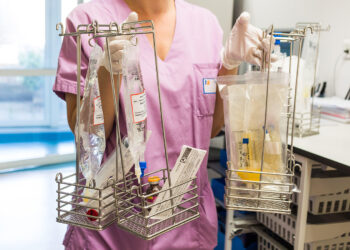[ad_1]
A 162-mg prophylactic daily dose of aspirin did not result in any significant difference in preeclampsia outcomes compared with a daily dose of 81 mg in pregnant women at risk for preeclampsia, according to a trial presented at the Society for Maternal-Fetal Medicine (SMFM) 2025 Annual Pregnancy Meeting.
“Our trial suggests that more aspirin may not necessarily be better for preeclampsia prevention in a high-risk population, with a potential for increased adverse events such as bleeding during pregnancy,” Amrin Khander, MD, an assistant professor of OB/GYN at Weill Cornell Medicine, New York City, told Medscape Medical News. “It is reassuring that for those who do elect to take 162 mg, the overall maternal and neonatal outcomes are the same. Further investigation is needed to confirm if 162 mg may be more beneficial for multifetal gestations.”
Though low-dose aspirin is known as the only prophylaxis for preeclampsia — reducing risk by up to 60% — it’s less clear what the optimal dose is. Because the only readily available dose available to US consumers is 81 mg, Khander and colleagues tested the protective effects of 81 mg or double that, 162 mg.
The researchers conducted a prospective randomized open-label pragmatic trial at the New York Presbyterian-Weill Cornell Manhattan and Queens campuses from January 2020 to August 2023. The primary outcome, incidence of preterm preeclampsia (
Secondary outcomes included a questionnaire about adherence and time to development of preeclampsia as well as spontaneous pregnancy loss, gestational age at delivery, blood loss at delivery, blood transfusion rates, maternal intensive care unit (ICU) admission, and neonatal ICU admission and length of stay.
The 369 participants were pregnant adults at least 16 weeks gestation who had one of the following: Prior history of preeclampsia, pregestational diabetes type 1 or type 2, preexisting hypertension, kidney disease, autoimmune disease, or multifetal gestation. Those with a major fetal malformation on ultrasound at 11-13 weeks were excluded as well as those with an aspirin contraindication or plans to deliver outside the hospital system.
The participants were an average 35 years old, with an average of one previous birth, and a pregravid body mass index (BMI) of 28 in the 162 mg group and 26 in the 81 mg group. There were similar proportions of qualifying comorbidities in each group, with the two largest being a history of preeclampsia (35% and 34%) and chronic hypertension (41% and 33%).
Most participants were commercially insured, with just over a quarter in each group on Medicaid. More than half of those enrolled were evenly divided between Asian, Black, or multiracial participants, with 41% White participants in the 162 mg group and 32% White participants in the 81 mg group. About a quarter of those in the 162 mg group (24%) and 18% in the 81 mg group were Hispanic or Latino participants.
After randomization, participants took one (n = 183) or two (n = 186) 81-mg aspirin tablets daily until delivery or alternate instruction from their obstetrician. Preterm preeclampsia or preeclampsia with severe features occurred in 13% of those taking 162 mg vs 14% of those taking 81 mg (P = .7).
Analysis of subgroups by qualifying comorbidity found that only those pregnant with multiples showed a significant difference, with a lower risk for preeclampsia in those taking 162 mg (odds ratio, 0.2; 95% CI, 0-0.9). Thirteen percent with multifetal gestation in the 162 mg group and 19% in the 81 mg group met the primary endpoint of preterm preeclampsia or preeclampsia with severe features.
“Given the physiologic increased placental volume in multifetal gestations or development of two placentas in dichorionic pregnancies, a higher aspirin dose in this population makes sense,” Khander said. For those with prior preeclampsia, however, the CI was wide, suggesting there may be no difference or only a small difference between the groups. “The findings from subgroup analyses should be considered exploratory, and further study is needed to confirm the findings,” he said.
Dawnette Lewis, MD, MPH, the director of the Center for Maternal Health at Northwell Health in New Hyde Park, New York, told Medscape Medical News that wanted to know more about the rates of preterm preeclampsia in each study group.
“There are previously published well-designed studies that have shown the benefit of the use of low-dose aspirin in decreasing the risk of preterm preeclampsia,” Lewis said. “I think it’s interesting that this study attempts to determine how low-dose aspirin affects preeclampsia in patients with preexisting medical conditions,” but the study was not powered to determine that effect. She was also interested in a weight-adjusted analysis by condition to see which preexisting conditions were more likely to results in preeclampsia.
Adherence rates were similar at each of three gestational time points between the groups, ranging from 88% to 92%. Newborns in the 162 mg group had significantly lower birthweights (2950 g) than those in the 81 mg group (3204 g; P = .01), but the difference was not clinically significant, Khander said.
Those in the 81 mg group also had a marginally significantly later gestational age of 38.1 weeks vs 37.7 weeks (P = .05). No other significant differences existed in secondary outcomes.
Overall rates of adverse events, defined as unscheduled interactions with the healthcare system, were higher in the 162 mg group (21%) than in the 81 mg group (12%; P = .02), but there were no significant differences in specific types of adverse events.
“Those on 162 mg were more likely to have bleeding episodes and triage visits for fetal heart rate tracings or elevated blood pressures, but the difference was not significant,” Khander told attendees.
Given prior meta-analyses suggesting that an aspirin dose > 100 mg is more protective against preeclampsia, Khander raised the question of whether their population was high risk enough. But he noted that their interim analysis supported their a priori estimations of preeclampsia and added that “most participants likely had multiple risk factors for low-dose aspirin use given our median age and pregravid BMI.”
Though this real-world study was relatively large and diverse, with high adherence, limitations included the open-label design, little geographic diversity, and a high proportion of commercially insured patients.
No external funding was noted. Khander and Lewis had no disclosures.
Tara Haelle is a health and science journalist based in Dallas.
[ad_2]
Source link : https://www.medscape.com/viewarticle/no-difference-preeclampsia-risk-one-vs-two-doses-81-mg-2025a10002to?src=rss
Author :
Publish date : 2025-02-05 09:23:30
Copyright for syndicated content belongs to the linked Source.














